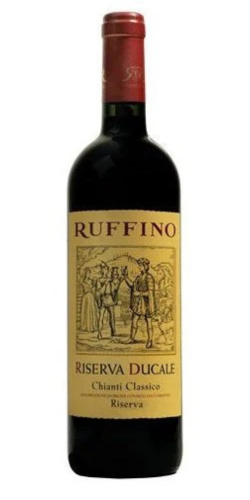
Our Rating

Chianti
Sangiovese
Wine lovers in the know, however, have long held Chianti, and its favorite grape, Sangiovese, in high regard, and this 2017 Ruffino Chianti Classico Riserva Ducale confirms that point.
The Ruffino story starts over 140 years ago in Pontassieve, a town outside of Florence, when two cousins, Leopoldo and Ilario Ruffino, believed they could produce better wines than many in the region were producing at the time. There was something special about the soil and the climate of Tuscany that wasn’t being represented in the local wine – the cousins set out to change that when they opened a small winery in 1877.
Shortly after Leopoldo and Ilario found their calling in the vineyard, international acclaim quickly followed. When the cousins began entering wine competitions, their Ruffino Chanti didn’t just place well, it cleaned up. The wine won a Gold Medal at the 1881 Milan Wine Exhibition, followed by another Gold Medal at the 1885 Antwerp Exhibition. Praise for the cousins’ wines spread quickly and ultimately reached the Duke of Aosta. For context, the Duke of Aosta is the title given to various princes in the dynasty of Sardinia or second sons of the reigning monarch; it’s similar to the title ‘Duke of York’ in the British Monarchy.
The Duke of Aosta found the wine so pleasing that in 1890 he named Ruffino, the official wine of the Italian royal family! For that reason, Ruffiano has dubbed this wine ‘Ducale’, which means duke, in a nod to the royal appointment of the cousins’ wine to the Italian court.
Another fast fact about this wine: According to Ruffino, they were the very first to export Chianti to the US market.
If you’ve ever shopped for Chianti wine, then you know how confusing navigating these wines can be. Because there are not one, not two, but three types of Chianti Classico!
Let’s start at the beginning. Chianti is the region within Tuscany where the wine hails from, and Sangiovese is the primary grape used to make Chianti wine. And, in order for a wine to be labeled ‘Chianti’, it must be made of 80-100% Sangiovese grapes.
Chianti Classico is a DOCG within the larger Chianti region, and this hilly region is considered the heart and soul of Tuscan winemaking. Wines labeled as Chianti Classico must be aged one year before it is released. This is considered “entry level” Chianti Classico.
Chianti Classico Riserva also comes from the Chianti Classico DOCG and is considered a slightly richer wine than Chianti Classico. These wines must be aged for two years in barrel, and an additional three months in bottle, before they can be sold. Some sippers prefer to age these a few years longer, so the wine is less dense. Regardless of when you open them, Chianti Classico Riservas, like the Ducale from Ruffino, make great food wines.
Ah, Chianti Classico Gran Selezione, the best of the best of this nimble DOCG. Gran Selezione became the newest addition to the Classico family when it was created in 2014. Wines with this designation must be 100% estate-grown fruit and spend 30 months aging in oak barrels. These wines must also pass an Italian tasting panel to confirm that they wine does indeed merit the ‘gran selezione’ label.
This also means that just because a winery’s Chianti Classico Gran Selezione receives approval one year doesn’t mean it will be approved in subsequent years.
This bottle of Ruffino Chianti Classico Riserva is a blend of 80% Sangiovese, 20% Cabernet Sauvignon / Merlot, but the “rules of Chianti” have ebbed and flowed over the years (actually centuries – references to “Chianti wine” go all the way back to the 14th Century).
The Sangiovese-dominant blend we now know today as Chianti was created by Baron Ricasoli, who championed the red grape for its acidity and cherry-earth notes. Ricasoli also believed, however, that Chianti should include white grapes like Malvasia to lighten the wine’s profile. If the winemaker preferred a less acidic interpretation, then it was canaiolo that should be added.
According to NY Times wine critic Eric Asimov, “By the 1960s, this suggested formula had hardened into rules, reified by bureaucrats who encouraged quantity over quality. Chianti was required to be a blended wine, and 10 to 30 percent of the blend had to be white grapes.”
Italian wine authorities continued to massage the rules, and by the 1990s, popular French grape varieties like Merlot and Cabernet were welcomed into the fold; white grapes were no longer permitted, and they remain banned from inclusion to this day.
Concentrated aromas of prunes, black currants, and pomegranate dominate the nose, with more earthy wet gravel, coffee, and green pepper emerging when the wine begins to breathe. Many Ruffino Chianti Classico reviews mention black cherry and earth flavors, and we certainly picked those up on the palate, particularly the sense of wet gravel, with its own distinct earthiness. Also present were black currant, graphite, and green pepper.
The Ruffino Riserva Ducale Chianti Classico is a drier wine with lively acidity and soft but noticeable tannins. The structure of this iteration of Ruffino red wine, combined with its acidity, makes it a great food wine. Pair this bottle with wild boar ragu, classic tomato-based pasta sauces or heartier Osso Bucco. Don’t forget the classic pizza and chianti pairing.
Italy
Chianti
Sangiovese
13
N/A
30 Minutes
Now to 2025
Ruffino


All things wine, and food you could ever need or want — straight to your email!